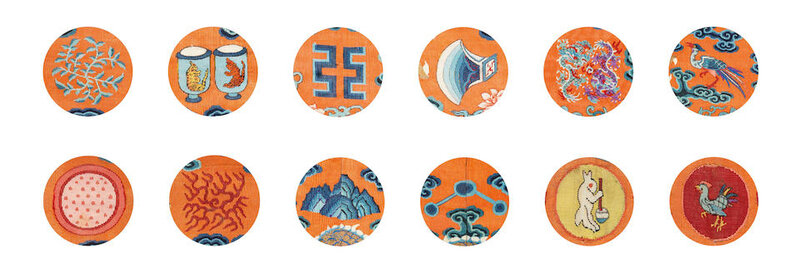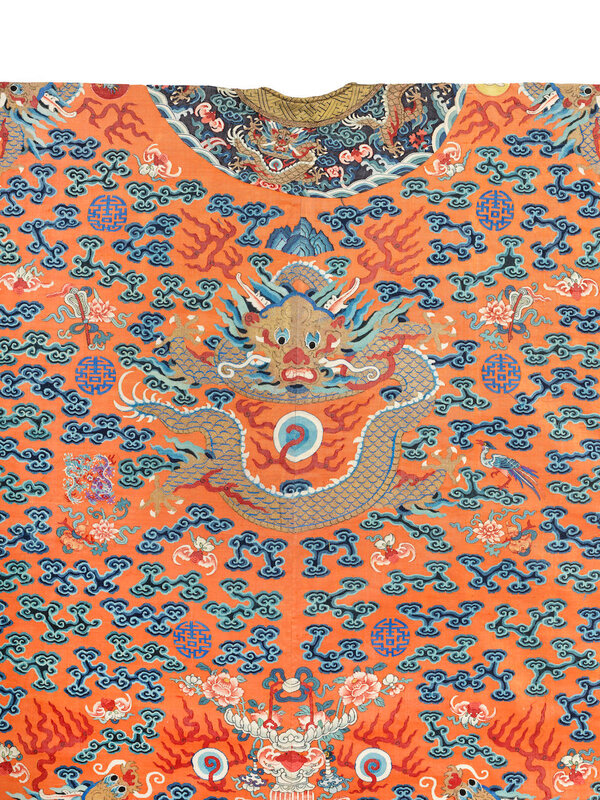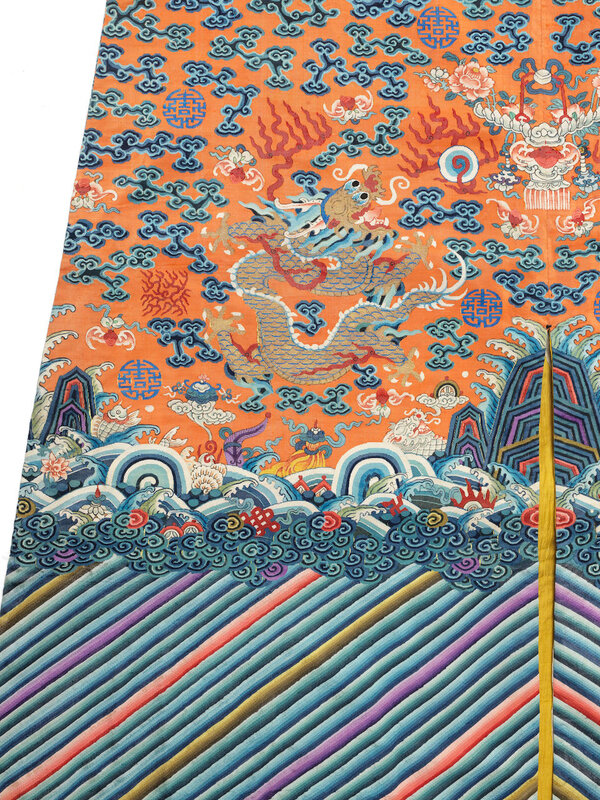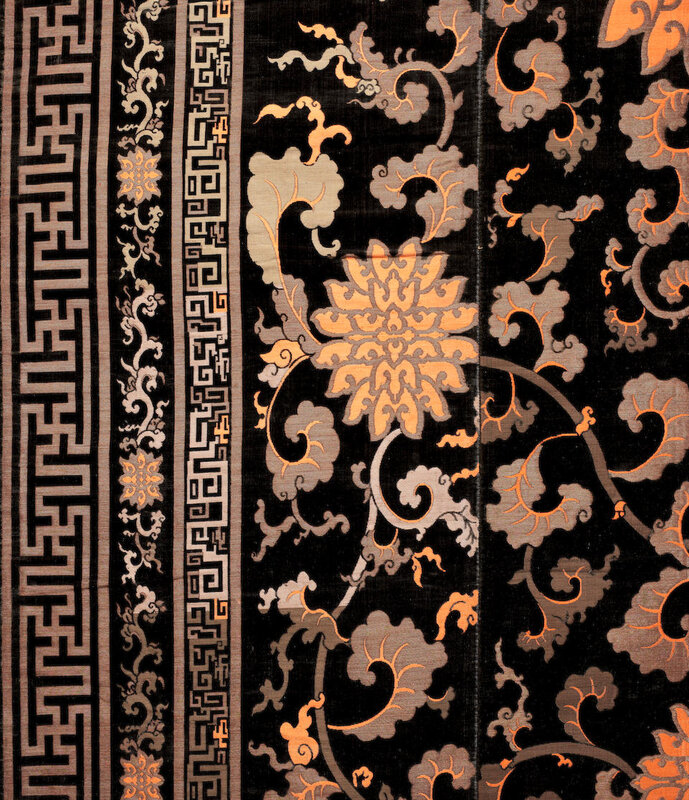The Multiple Shades of Power. A Fine Selection of Imperial Chinese Textiles at Bonhams London, 7 november 2019
Lot 132. An exceedingly rare Imperial kesi orange-ground twelve-symbol robe, 19th century; 183cm (72in) wide x 145cm (57in) long. Estimate: £8,000 - £12,000. Photo: Bonhams.
LONDON - Bonhams Fine Chinese Art auction will showcase a fine selection of Imperial textiles dating to the Ming and Qing dynasties. Leading the group is an exceedingly rare Kesi Orange-ground 'Twelve-Symbol' robe, 19th century (Lot 132), superbly woven with Nine resplendent five-clawed Dragons, the robe, which is estimated at £150,000-250,000. The decoration of an Imperial robe with the Twelve Symbols was strictly regulated and permitted for the sole use of the Emperor or Empresses. The combination of the Twelve Symbols with the orange colour is particularly rare and the present robe was likely made for the Guangxu Emperor (1875-1908). This robe is particularly prized for its pristine condition and vivid colours.
Lot 132. An exceedingly rare Imperial kesi orange-ground twelve-symbol robe, 19th century; 183cm (72in) wide x 145cm (57in) long. Estimate: £150,000 - 250,000 (€ 170,000 - 290,000). Unsold. Photo: Bonhams.
The kesi ground finely worked in satin stitches in shades of blue, green, red, aubergine and ochre couched vibrant gold threads with nine five-clawed dragons pursuing 'flaming pearls' amidst trialling ruyi clouds interspersed with bats; the Twelve Imperial Symbols arranged in three groups of four beginning with the sun, moon, constellation and mountains around the neck; the axe head, the fu symbol, paired dragons and pheasant around the upper body of the robe; the water weed, pair of sacrificial vessels, fire and grain above the terrestrial diagram and lishui stripe at the hem, all interspersed with the Eight Buddhist Emblems and further dragons emerging from rolling waves, against a rich apricot ground; the matching dark blue-ground cuffs and collar worked with further dragons amidst bats, clouds and waves, below sleeve extensions woven with roundels depicting further dragons chasing flaming pearls, lined in original imperial yellow silk, with a three-character inscription and seal mark on the inside flap.
Provenance: Linda Wrigglesworth, London, 1997
A Western private collection.
Superbly woven in the refined kesi technique with nine resplendent, lively, five-clawed dragons riding the heavens and finely worked in metallic gold threads amidst a profusion of shaded blue trailing clouds interspersed with the Twelve Symbols of Imperial Sovereignty, the present robe is exceptionally rare for its pristine condition. No identical examples would appear to have been preserved in public collections.
The yellow lining, dragon cuffs, neck bands and gold brocade edgings are all original to the robe. In addition, the imperial dragons emerging from the turbulent waves and the roundels depicting further dragons, woven within the rich midnight-blue ground of the sleeve extensions, are very unusual and rarely encountered on imperial orange-ground robes.
This robe probably dates to the 1880s and may have been worn by the Guangxu emperor (1871-1908) during the earlier years of his reign. The apricot-orange colour xinghuang, is referred to in the Huangchao liqi tushi 皇朝禮器圖式 ('Illustrated Precedents for the Ritual Paraphernalia of the Imperial Court'), edited in 1759, as one of the 'Five Imperial Yellows' used at the Qing Court, which could only be worn by Princes and Princesses of the First Rank and Imperial Consorts of the Second and Third Degree (See note 1).
Following the death of the Tongzhi emperor in 1875 and in the absence of an immediate heir, his mother, the formidable Dowager empress Cixi, designated her four-year old nephew, Zaitian, to be successor to the throne as the Guangxu emperor, although she continued to be in control of the government for the first fourteen years of the new ruler's reign (See note 2). At this time, the court dress legislation, promulgated by the Qianlong emperor more than a century earlier, appears to have become similarly adapted to these new circumstances. Not only do numerous portraits depict the Dowager empress wearing imperial yellow robes, as was appropriate to her rank, but also a few 'Twelve-Symbol' robes, dating to the Guangxu emperor's reign, survive displaying a wide range of the basic ground colours. These deviations probably reflected Cixi's break from the Court conventions of previous times, particularly when she appointed her nephew Zaitian, a cousin of the Tongzhi emperor's, to succeed him (See note 3). Within this context, an apricot-ground 'Twelve-Symbol' robe would have certainly been considered appropriate to signify the young Guangxu emperor's status as heir apparent, when he had not yet formally assumed control of the government (See note 4).
The quintessential symbol of imperial power, five-clawed dragons embodied royalty and dominion and expressed the visual metaphor of the good ruler who behaved wisely for the wellbeing of his subjects. The Twelve Symbols of Imperial Authority further reinforce the emperor's essence over eloquence, articulation, forcefulness and vigour. According to the 'Book of History' (Shujing 書經), the legendary Emperor Shun, believed to have ruled during the third millennium BC, referred to these symbols as suitable decoration for imperial formal attire and in 1766, the Qianlong emperor restricted the use of these motifs to imperial robes (See note 5).
A rigid scheme defined the position of the Twelve Symbols on the robes. The sun, moon, stars, and mountain, symbolised the four main ceremonies which the emperor presided throughout the year at the Altars of Heaven, Earth, Sun and Moon. They were placed in pairs at the shoulders, chest and mid-back area. The paired dragons, the golden pheasant, the confronted ji character and the hatchet, represented all things on earth and the ruler's ability to make decisions. They decorated the chest area, while the sacrificial vessels, the aquatic grass, the grains of millet and the flames, representing ancestor worship and four of the Five Elements, were placed at the mid-calf level of the coat.
The seven-shaded lishui bands are flawlessly woven and include the aniline purple tone, which was imported into China from Europe circa 1863 and was highly-favoured by the Dowager empress Cixi (See note 6).
Compare with a related orange-ground, 'Twelve-Symbol' kesi robe, Guangxu period, lacking the water dragons from the foaming waves in the lishui and featuring the more common gilded stripes on the sleeve extensions instead of the woven 'dragon' roundels, which decorate the present robe, from the Mactaggart Art Collection, University of Alberta Museum, Alberta, illustrated by J.Vollmer and J.Simcox, Emblems of the Empire, Alberta, 2009, pp.30 and 31.
Further highlights include a very large yellow-ground silk 'dragon panel', Qianlong (1736-1795) (Lot 145), estimated at £30,000-50,000. Impressive in its exceptionally large size, this remarkable brocade testifies to the scale and opulence of the Qianlong Court probably complemented the elaborate setting of one of the Imperial ceremonial halls within the Forbidden City.
Lot 145. An exceptionally large and rare Imperial yellow-ground embroidered silk 'dragon' panel, Qianlong period (1736-1795); 364cm (143 2/8in) long x 239cm (94cm) wide. Estimate: £150,000 - 250,000 (€ 170,000 - 290,000). Sold for £ 31,312 (€ 36,561). Photo: Bonhams.
The massive panel with an impressive central gilt-couched front-facing five-clawed dragon clutching a flaming pearl, flanked by two side-facing dragons amongst further flaming pearls interspersed amidst colourful ruyi cloud scrolls and above crashing waves.
Provenance: Linda Wrigglesworth, London
Note: Superbly woven and impressive in its exceptionally large size, this magnificent brocade is a splendid testament to the scale and opulence of the Qianlong court. This panel was probably the central part of a very large imperial hanging which functioned either as a backdrop or curtain in one of the ceremonial halls within the Forbidden City. The complete panel would have likely consisted of nine writhing dragons interspersed within a celestial landscape of clouds, mountain and waves.
Capable of flying high in the sky and diving back in the sea, dragons were regarded in China as intermediaries between Heaven and Earth and empowered with extraordinary powers that compared with those of the emperors. In conjunction with the flaming pearl, the dragon formed the visual metaphor of the good ruler who behaved wisely for the well being of his subjects.
A closely related Imperial yellow-ground 'dragon' panel, mid-18th century, featured as the central part of a massive curtain hanging, is illustrated by R.Jacobsen, Imperial Silks: Chi'ing Dynasty Textiles In The Minneapolis Institute Of Arts, Minneapolis, 2002, pp.956-957, cat.no.474.
A midnight-blue-ground silk 'dragon' panel, dating to the Kangxi (1662-1722) (Lot 144), estimated at £30,000-50,000, is brilliantly woven in gold and five-coloured silk threads and displays the extraordinary weaving of the early Qing dynasty.
Lot 144. A very large and Imperial midnight-blue-ground silk embroidered 'dragon' panel, Kangxi period (1662-1722); 217cm (85 1/2in) x 93cm (36 1/2 in). Estimate: £30,000 - 50,000 (€ 35,000 - 58,000). Sold for £ 31,312 (€ 36,561). Photo: Bonhams.
The rectangular panel finely embroidered with a powerful five-clawed dragon featuring a sinuous body finely picked up in dense couched gold thread and leaping above tumultuous waves in pursuit of a partially-visible 'flaming pearl', surrounded by colourful wispy clouds, all on a midnight-blue ground.
Provenance: a Hong Kong private collection, late 1980s
John Eskenazi Ltd., London, 1990
An English private collection, 1994-2005
John Eskenazi Ltd., London, 2007
Christopher Bruckner Asian Art Gallery, London, 2007
A European private collection.
Published and Illustrated: J.Eskenazi, Chinese Silk Textiles from 14th-18th Century, Milan, February-March 1995
Hali, magazine issue 79, February / March 1995, pp. 58-59
Christopher Bruckner, Chinese Imperial Patronage: Treasures from Temples and Palaces, London, 2005, no.33.
Note: The powerful dragon on the present panel displays the extraordinary weaving of the imperial workshops of the Qing dynasty. This panel probably formed part of a very large imperial hanging that functioned either as a backdrop or curtain in one of the ceremonial halls within the Forbidden City. Brilliantly woven in gold and five-coloured silk threads, the dragon features a shining face and scales that contrast with its matte tongue, mane, and claw tips.
In style, the present embroidery closely compares with a silk hanging of a full-faced dragon embroidered on a velvet panel, 17th century, illustrated in Heavens' Embroidered Cloths. One Thousand Year of Chinese Textiles, Hong Kong, 1995, no.9. Also compare with a similarly rendered dragon, Kangxi, illustrated in Weaving China's Past. The Amy S. Clague Collection of Chinese Textiles, Phoenix, 2000, no.22.
Finally, two large Imperial velvet 'Lotus' dais covers, dating, respectively, to the Yongzheng period (1723-1735) (Lot 137), estimated at £60,000-80,000 and mid-Qing dynasty (18th/19th century) (Lot 140), estimated at £50,000-80,000, were probably produced for the Imperial Court in workshops based in Fujian and Jiangsu Provinces. Constructed of three silk-velvet panels which were joined together after weaving, these lavish hangings underscored powerful religious associations relating to the attainment of immortality. The rich strawberry-red and gold coloured lotus flowers in fact recall the transmutation of cinnabar into gold, a Daoist alchemic process aimed at driving away the malignant spirits, allowing the practitioner to ascend to heaven.
Lot 137. A rare and large Imperial 'lotus' velvet dais cover, Yongzheng period (1723-1735); 350cm (137 6/8in) x 190cm (74 7/8in). Estimate: £60,000 - 80,000 (€ 69,000 - 93,000). Unsold. Photo: Bonhams.
The cover consisting of three joined panels of cut and uncut silk velvet, centred with a large orange lotus bloom surrounded by six smaller blooms, all outlined in silvery-grey thread on a dense ground of curly-leafed scroll designs in gilt metal-wrapped thread on a honey-coloured cut-pile background, enclosed within a triple border of geometric fretwork, meandering lotus scroll and key-fret.
Provenance: The Textile Gallery, London, 1982
Lady Schiennen, Kent, England
Christopher Bruckner Asian Art Gallery, London, 2007
A European private collection.
Published and Illustrated: Christopher Bruckner, Chinese Imperial Patronage: Treasures from Temples and Palaces, London, 2005, no.33.
Note: Sumptuous covers made of delicate silk velvet, such as the present example, are extremely rare and were produced in limited quantities for the imperial court in workshops based in Fujian and Jiangsu Provinces. Constructed of three silk-velvet panels which were joined together after weaving, this lavish carpet was probably meant to cover important furniture, such as the kang platform of an imperial residence that was heated by braziers and supported other furniture.
The rich honey-coloured ground and the interlocking key-fret designs ending with dragon heads, which the present example displays, appear to be features characterising the earliest production of silk velvet carpets in China, datable to late 17th/early 18th century. See a honey-ground silk velvet carpet, late 17th/early 18th century, decorated with blossoming lotus and similar interlocking designs ending with dragon heads, from the Art Institute of Chicago, illustrated by J.Vollmer, Clothed to Rule the Universe. Ming to Qing Dynasty Textiles at the Art Institute of Chicago, Chicago, 2000, pl.30, pp.47.
Finely woven in the brilliant shades of cinnabar red and golden yellow, the panel evokes powerful religious associations concerning the attainment of immortality. Emerging from the mud, lotus flowers were a highly-regarded symbol of Buddhist purity and enlightenment. Both sutras and actual depictions of Buddhist realms, dating from at least the fourth century, relate to the lotus calyx as means releasing the reborn souls into the Pure Land presided by Buddha Amitabha. The blossoming red flowers, however, also recall the transmutation of cinnabar into gold, a Daoist process aimed at driving away the malignant spirits and ascending to heaven in broad daylight.
Compare with a similar but later silk velvet cover, late 18th century, woven in gold metal-wrapped thread with orange blossoming lotus amidst meandering leafy scrolls on a navy ground, from the collection of the Minneapolis Institute of Art, illustrated by R.Jacobsen, Ch'ing Dynasty Textiles in the Minneapolis Institute of Arts, Minneapolis, 2002, vol.2, pp.1094, cat.no.543.
Lot 140. A rare and large imperial 'lotus' velvet dais cover, Mid-Qing Dynasty; (137 6/8in) x 190cm (74 7/8in). Estimate: £60,000 - 80,000 (€ 69,000 - 93,000). Unsold. Photo: Bonhams.
The cover consisting of three joined panels of cut and uncut silk velvet, centred with a large orange blossoming lotus surrounded by six smaller blooms, all on a dense ground of curly-leafed scroll designs in gilt metal-wrapped thread on a black background, enclosed within a triple border of geometric fretwork, meandering lotus scroll and key-fret.
The Property of a Gentlemen.
Provenance: Danon, Rome
A European private collection.
Note: Finely woven in brilliant shades of cinnabar red and golden yellow, the sumptuous carpet evokes powerful religious associations concerning the attainment of immortality.
Emerging from the mud, lotus flowers were a highly-regarded symbol of Buddhist purity and enlightenment, however, they also recall the transmutation of cinnabar into gold, a Daoist practice aimed at driving away the malignant spirits and ascending to heaven in broad daylight. According to the 'Records of the Great Historian', Shiji, compiled during the first century BC, the alchemical method was first performed by the mythical Yellow Emperor and promoted by Li Shaojun, a Han specialist in astrology, divination and geomancy. The process involved the presentation of offerings to an alchemical stove in order to summon the supernatural beings. During this ritual, cinnabar was transformed into gold and employed to manufacture food and drink vessels that were thought of prolonging one's life and granting admission in the ranks of the celestial bureaucracy. For references see F.Pregadio, Great Clarity: Daoism and Alchemy in Early Medieval China, Stanford, 2006.
A closely related rectangular silk velvet panel, early 19th century, centred with large lotus blossoms surrounded by six smaller blooms amongst foliate scrolls enclosed within a triple border of scrolling lotus and key fret is illustrated by R.Jacobsen, Ch'ing Dynasty Textiles in the Minneapolis Institute of Arts, Minneaapolis, 2002, vol.2, pp.1094, no.543.

/https%3A%2F%2Fprofilepics.canalblog.com%2Fprofilepics%2F1%2F0%2F100183.jpg)
/https%3A%2F%2Fstorage.canalblog.com%2F03%2F02%2F119589%2F96711876_o.jpg)
/https%3A%2F%2Fstorage.canalblog.com%2F11%2F31%2F119589%2F94773502_o.jpg)
/https%3A%2F%2Fstorage.canalblog.com%2F20%2F83%2F119589%2F94772815_o.jpg)
/https%3A%2F%2Fstorage.canalblog.com%2F26%2F72%2F119589%2F75604929_o.jpg)
/https%3A%2F%2Fstorage.canalblog.com%2F59%2F60%2F119589%2F26458628_o.jpg)

























/http%3A%2F%2Fstorage.canalblog.com%2F00%2F00%2F119589%2F129758935_o.jpg)
/http%3A%2F%2Fstorage.canalblog.com%2F29%2F28%2F119589%2F129637299_o.jpg)
/http%3A%2F%2Fstorage.canalblog.com%2F88%2F37%2F119589%2F129631480_o.jpg)
/http%3A%2F%2Fstorage.canalblog.com%2F77%2F79%2F119589%2F129631259_o.jpg)